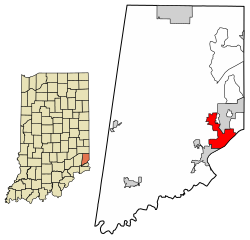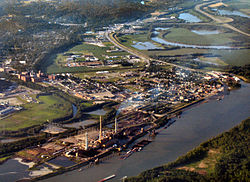2010 census
As of the census [13] of 2010, there were 5,042 people, 2,057 households, and 1,142 families living in the city. The population density was 1,020.6 inhabitants per square mile (394.1/km2). There were 2,313 housing units at an average density of 468.2 per square mile (180.8/km2). The racial makeup of the city was 93.5% White, 3.0% African American, 0.3% Native American, 0.8% Asian, 0.3% from other races, and 2.2% from two or more races. Hispanic or Latino of any race were 1.2% of the population.
There were 2,057 households, of which 31.3% had children under the age of 18 living with them, 31.4% were married couples living together, 17.8% had a female householder with no husband present, 6.3% had a male householder with no wife present, and 44.5% were non-families. 39.1% of all households were made up of individuals, and 13.5% had someone living alone who was 65 years of age or older. The average household size was 2.26 and the average family size was 2.96.
The median age in the city was 35.5 years. 24.1% of residents were under the age of 18; 10.6% were between the ages of 18 and 24; 26.6% were from 25 to 44; 24.1% were from 45 to 64; and 14.7% were 65 years of age or older. The gender makeup of the city was 49.0% male and 51.0% female.
2000 census
As of the census [4] of 2000, there were 4,685 people, 1,914 households, and 1,140 families living in the city. The population density was 956.1 inhabitants per square mile (369.2/km2). There were 2,162 housing units at an average density of 441.2 per square mile (170.3/km2). The racial makeup of the city was 93.81% White. The two largest ethnic groups in Lawrenceburg and Lawrenceburg Township are 29% German Americans, and 19% Irish Americans, 4.18% African American, 0.15% Native American, 0.45% Asian, 0.04% Pacific Islander, 0.32% from other races, and 1.05% from two or more races. Hispanic or Latino of any race were 0.85% of the population.
There were 1,914 households, of which 31.0% had children under the age of 18 living with them, 36.2% were married couples living together, 18.4% had a female householder with no husband present, and 40.4% were non-families. 34.4% of all households were made up of individuals, and 13.5% had someone living alone who was 65 years of age or older. The average household size was 2.28 and the average family size was 2.94.
In the city, the population was spread out, with 24.2% under the age of 18, 11.5% from 18 to 24, 28.3% from 25 to 44, 20.1% from 45 to 64, and 15.8% who were 65 years of age or older. The median age was 35 years. For every 100 females, there were 88.5 males. For every 100 females age 18 and over, there were 86.4 males.
The median income for a household in the city was $29,306, and the median income for a family was $37,978. Males had a median income of $31,543 versus $21,985 for females. The per capita income for the city was $15,656. About 10.3% of families and 14.9% of the population were below the poverty line, including 17.9% of those under age 18 and 23.8% of those age 65 or over.




